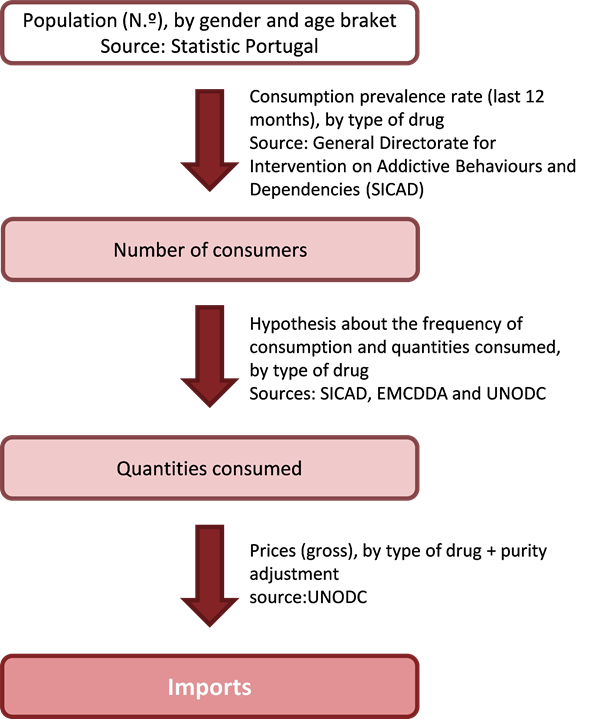 PORTUGAL: Tobacco Smuggling and Drug Trafficking in the International Accounts
PORTUGAL: Tobacco Smuggling and Drug Trafficking in the International Accounts
Introduction
The illegal activities have been considered within national accounts since the changeover to the ESA2010. Within the balance of payments domain, this development has occurred with the 2019 benchmark revision (data published by October 2019) and affected the entire time span of the series. For international transactions, only tobacco smuggling and drug trafficking are considered. With regard to alcohol smuggling, it is assumed not to be relevant in Portugal. Similarly, an estimation of prostitution activities was only included in the internal component of national accounts.
Exports of illegal activities represent about 0.04% of total exports of goods and around 0.07% of total imports in 2017.
Scope, Methodology, Compilation Practices, and Data Sources
The estimation of illegal activities is manly performed by the Statistical Office of Portugal (Instituto National de Estatistica de Portugal (PT-INE)) within the national accounts framework and shared with Banco de Portugal for balance of payments purposes. This estimate is based on guidelines agreed between Eurostat and Member States to ensure comparability of results.
In this context, it is assumed that the consumption of drugs is assured by imports while exports are null. The calculation of the value of drug imports is based on consumption data (demand side perspective), after a seizure-based approach (supply side perspective) being tested and revealing weaknesses.
The drugs considered are cannabis, cocaine, ecstasy (or MDMA) and heroin (or opium). Other drugs are not considered due to the low prevalence of their use.
Determining the value of drug imports involves multiple sources of information and it is complex, as there is not a single source that indicates the amount consumed. Basically, it follows the following path:
Note: European Monitoring Centre for Drugs and Drug Addiction (EMCDDA), United Nations Office on Drugs and Crime (UNODC).
For tobacco smuggling, the main source of information are the reports on fraud combat, tax and customs evasion published by the Office of the Secretary of State for Fiscal Affairs and available annually.
This information is especially useful as, unlike drug trafficking, it enables to obtain almost directly the value of illegal tobacco exports through the value of seizures. The methodology follows the approach proposed by Eurostat (supply side perspective) which is based in two main assumptions: i) seizures are a proportion of imports; ii) exports are equivalent to imports (price/margins adjusted), based on the conclusions of the same report that tobacco seized in Portugal is mainly intended for the European market, and our country is only a gateway to Europe.
Therefore, the only adjustment to be made to imports is to convert the value (in euro) of street price seizures to wholesale prices using, in the absence of better information, the cannabis margin (retail price/wholesale price). Exports are valued according with the value of seizures.
Given that the value of seizures in each year is very volatile and may not reflect consumption behavior, we assume for each year the average of the values of the last three known years.
Linkages Across Statistical Domains
With the 2019 benchmark revision, external statistics produced by Banco de Portugal begin to encompass an estimate of illegal activities which is equivalent to the one incorporated in national accounts. During the benchmark revision process a major effort was devoted to enhancing the coherence between the non-financial accounts (PT-INE responsibility) and external statistics (Banco de Portugal responsibility).
Given that the estimation of illegal activities requires information that Banco de Portugal does not have access on a regular basis and that on the other hand PT-INE deals with this type of data in a more thoroughly manner, Banco de Portugal decided to adopt PT-INE figures.
Thus, the strategy involves incorporating directly in the balance of payments domain the entire set of results estimated by INE. However, PT-INE’s estimation is not produced in a timely manner for the monthly compilation of the balance of payments statistics, therefore an advanced procedure was introduced to anticipate the PT-INE’s annual estimation. This model was developed assuming the same approach as the INE model, in order to minimize revisions upon PT-INE data disclosure. Further, Banco de Portugal compiles the monthly figures on the basis of the methodology used to compile the annual figures in order to have compatible periodicity data on illegal activities for the monthly balance of payments.
Current Challenges and Conclusions
Since the calculation of illegal activities is based on an estimation, it suffers from some drawbacks, namely:
- Absence of monthly indicators of illegal activities that allow to impose some seasonality on consumption over the estimated annual values.
- Time lag between available sources and the need to compile monthly balance of payments statistics.
- Lack of sources to estimate possible services associated with illegal balance of payments activities.
Annexes
http://www.emcdda.europa.eu/emcdda-home-page_en
https://www.unodc.org/unodc/en/data-and-analysis/drug-production-and-trafficking.html



